Voters, including Republicans, oppose gov. punishing critical speech | Weekly roundup for September 28, 2025
Also this week: Immigration attitudes move left; NSF cuts hit red states hard; Can Democrats become the anti-corruption party?; + more!
Dear readers,
There are two big stories in Washington this week. One is that the government is about to shut down, which I covered in my Friday Chart of the Week, as well as in this conversation with Paul Krugman.
The other story is Trump’s continued imperial bullying of his political opponents. That includes (all of these events happened this week): his continued calls for media censorship (he said he’ll try to sue ABC over bringing back Jimmy Kimmel), the sudden indictment of James Comey for allegedly committing perjury during a 2020 testimony to the Senate, and the president’s Thursday night executive order instructing the justice department to go after left-wing “terrorist organizations” (the DOJ is now looking for charges against several non-profit groups that give to Democratic causes — and are not in fact recruiting terrorists).
Since I have already covered the former, this week’s Sunday post focuses on new polling related to the latter. As ever, if you have data for me to share, leave it in the comments below!
People (including Republicans) don’t want the government censoring free speech
I will begin by taking a victory lap: Jimmy Kimmel is back on air because of Strength In Numbers.
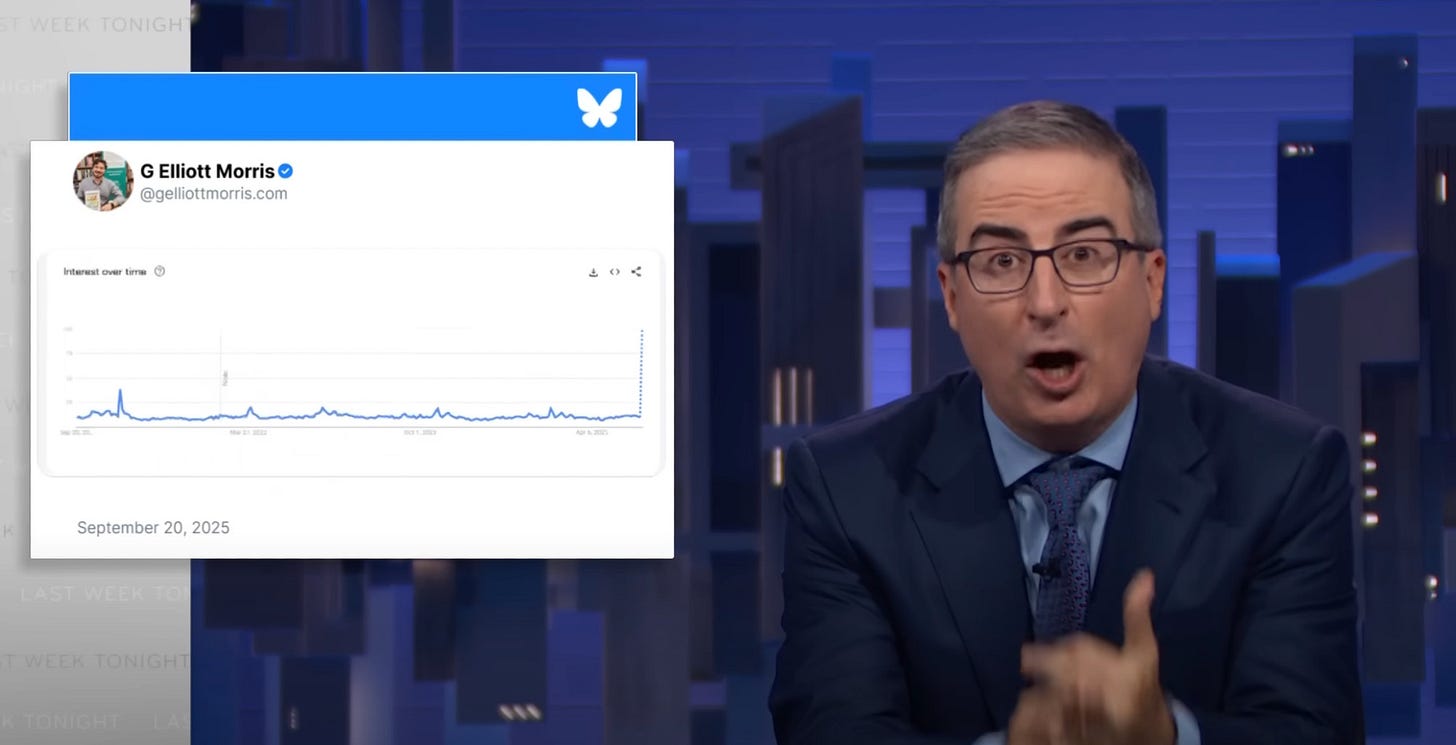
OK, that’s a joke — I’m not deluded enough to think that my writing alone could change enough minds to put a show with a $200 million budget back on air.
On a more serious, related note: A new YouGov/The Economist poll this week finds voters really don’t like it when the government tries to punish news networks for the content of their speech. According to YouGov, 68% of Americans say it is “unacceptable” for the government to be “pressuring broadcasters to remove shows that include speech [government officials] disagree with”. (It is very hard to get 68% of the public to agree on anything.)
A plurality of Republicans also say that threatening government action as a consequence of unfavorable speech is bad!
YouGov also finds an increase in the share of Democrats and political independents who rate civil rights as their “most important issue.”
I predicted this level of backlash in last week’s Friday newsletter.
But more importantly, Kimmel coming back is a win for the First Amendment. I don’t really watch TV, and especially not the late-night shows, but it was wrong for Carr to pressure broadcast networks into canceling his show, and I’m glad someone at Disney came to their senses and reinstated him (or maybe they just saw the potential money in Democrats rushing to watch a Kimmel return monologue).
This is a good reminder of the power of public opinion when people express their attitudes with real-world actions (in this case, maybe the largest Disney boycott in recent memory.
What you missed at Strength In Numbers
Subscribers to Strength In Numbers received five articles over the last seven days:
A post about how unpopular Trump is, and how people underestimate the intensity of opposition to Trump at their own peril:
A write-up of our September Strength In Numbers/Verasight poll!
A re-analysis of recent polling people are using to claim Democrats are “talking too much” about left-wing issues, such as LGBTQ and climate change, but does not actually tell us anything about causality (and obscures a bigger point on the importance of different issues):
A look at what our poll says about the government shutdown:
And Paul Krugman interviews me about Trump, free speech, economic sentiment, democracy, and more:
Paul Krugman and Elliott Morris talk about Trump, the economy, and democracy
Happy Saturday, readers,
Every day is a good day to become a paid supporter of Strength In Numbers. You get extra premium posts at least once a week (and, lately, more like 2-3x a week), an early look at any data products I’m developing, access to a private Discord server just for paid members, and more. You also support all the work that goes on behind the scenes to put together the SIN/Verasight poll, my state and congressional district MRP models, and all the other data analysis that powers my journalism.
Even more numbers!
A collection of links from the last week:
Semafor: “Democrats desert legacy media for new outlets.”
Stanford professor Adam Bonica makes the case that Democrats can do a true political realignment by becoming the anti-corruption party.
A new Associated Press-NORC poll finds Americans are more likely than they were a year ago to think immigrants in the country legally benefit the economy, that immigrants “enrich American culture and values,” and that we should raise the number of legal immigrants we allow into the country.
The New York Times has a good piece showing (in my editorialization) how Trump views government data as a propaganda tool, not an empirical measurement of reality
The Pew Research Center finds a big increase in the share of Americans who say they get news from TikTok — especially among young Americans. According to Pew, 43% of adults under 30 say they “regularly” get news from TikTok now:
Also this week: An investigation by Gizmodo found the social media backlash to Cracker Barrel’s mundane logo change was driven by bot networks (so I’m skeptical this use of social platforms for news will result in a more informed public).
An analysis of Trump’s 50% reduction in the FY26 budget for the National Science Foundation finds that it will lead to roughly $11 billion in economic losses around the country. The impact seems really bad in university towns, but also lots of red parts of the country; here’s a handy map:
A study of support for partisan *murder* (not “violence,” “murder”) finds just 1% of adults support it, down from 3% last year.
The data team at The Economist (my former colleagues!) is now circulating their long-running weekly data journalism newsletter here on Substack. One addition that caught my eye is about political violence in America (it’s not a left-wing thing, The Economist says), and how one of their journalists used survey data and machine learning to sort Republican voters into 5 distinct groups based on their policy preferences, general political attitudes, and other traits:
The New York Times does a good experiment into how question wording affects New Yorkers’ apparent support for Zohran Mamdani’s agenda.
Friend of the site Mike Podhorzer and Farrah Bostic talk about what Democrats could do to repair their brand (currently pretty bad, though not as bad as aggregate statistics make it seem).
That should be enough links to keep you busy until next week (or month). Enjoy!
Updates from the data portal
Trump approval: Trump’s topline approval rating has ticked down about one point over the last week — though, as with any week-to-week period in the last ~3 months, the story is mostly of stability of opinion. Attitudes about Trump don’t move by much more than a few points without a really big event (apparently, bigger than the shooting of Charlie Kirk and everything the president has done in the aftermath):
Trump issue approval: But while Trump’s overall rating hasn’t budged, his rating on a few key issues has. Over the last ~2 weeks, he has lost significant ground on his handling of jobs, inflation, and health care:
House generic ballot average: Democrats have slightly expanded their lead in the generic ballot, from +3.1 to +3.5 points, but there is not a lot of polling and a decent amount of noise in the data. I wouldn’t pay much mind to shifts smaller than a point unless they stick around for a week or more:
The charts on the data portal update every day. Feel free to use and cite them liberally!
That’s it for your major political data stories this week.
Got more for next week? Email your links or add to the comments below!
Have a nice week,
Elliott



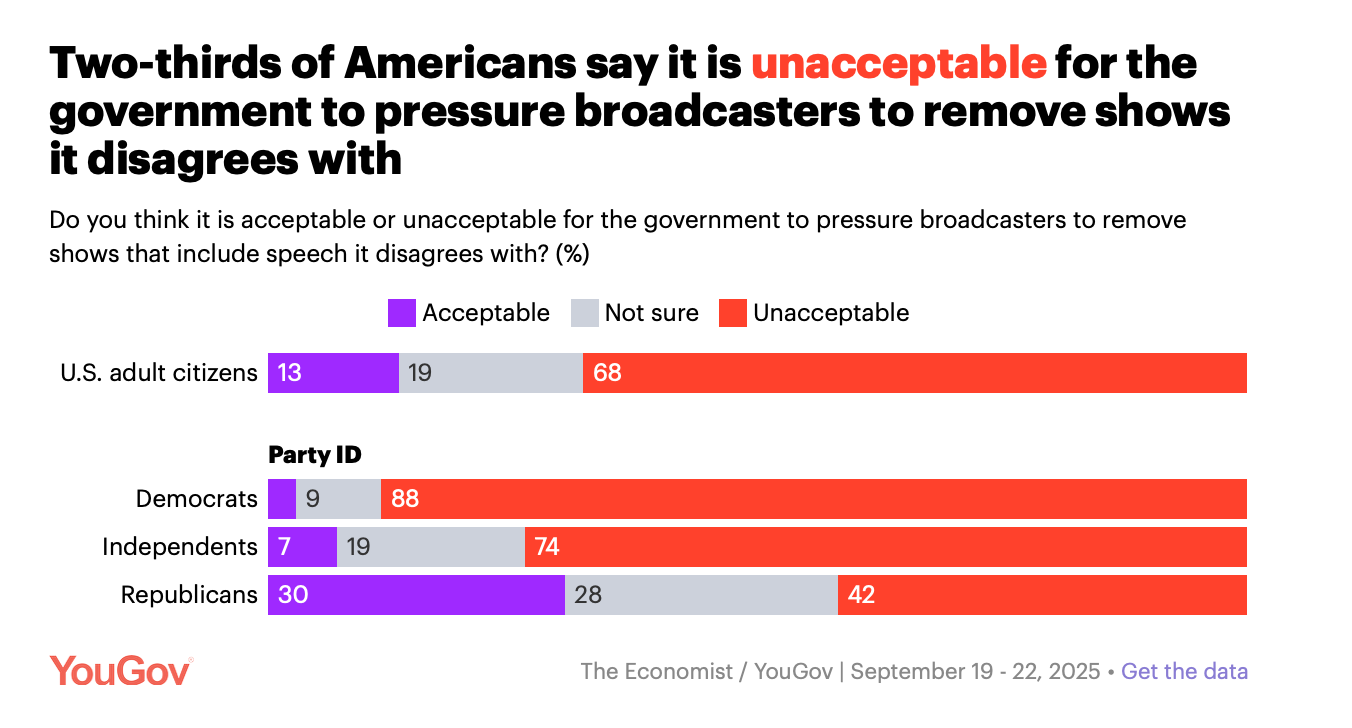
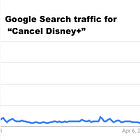
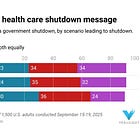
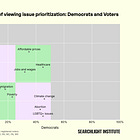


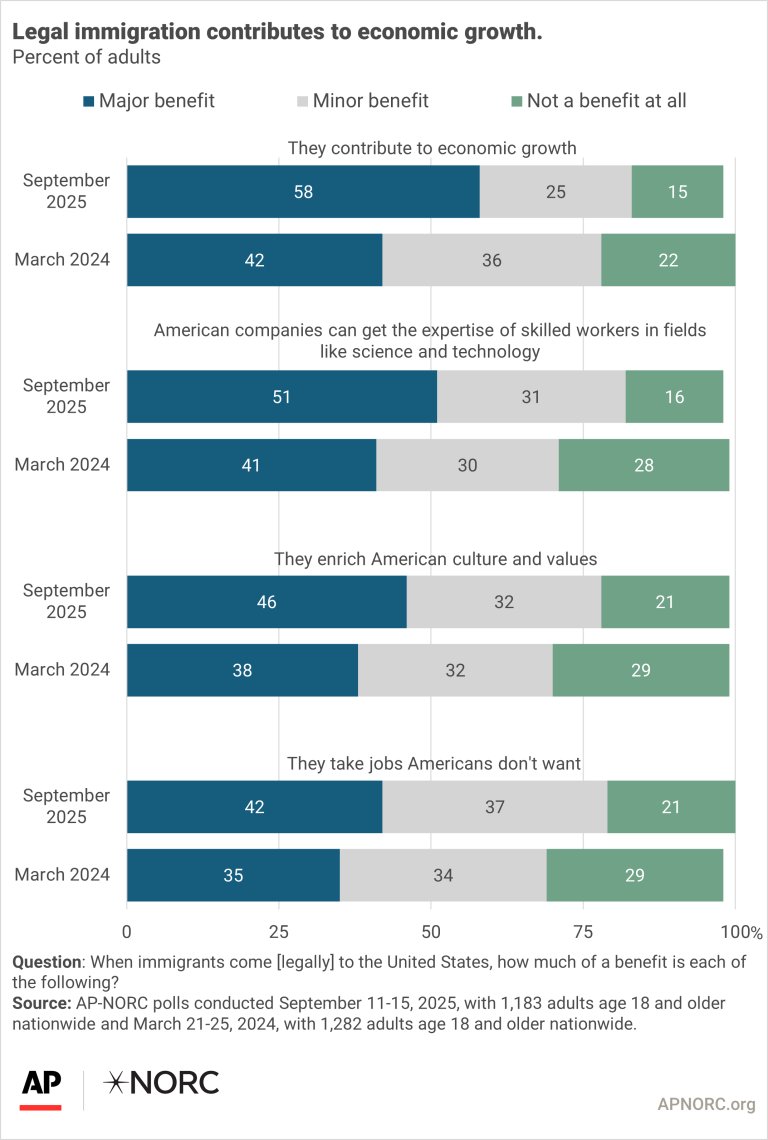
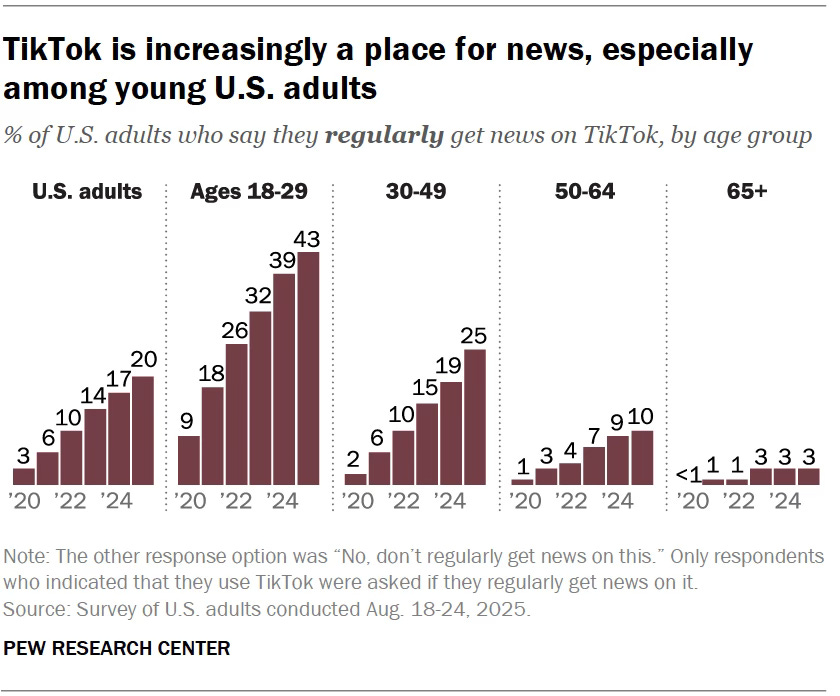
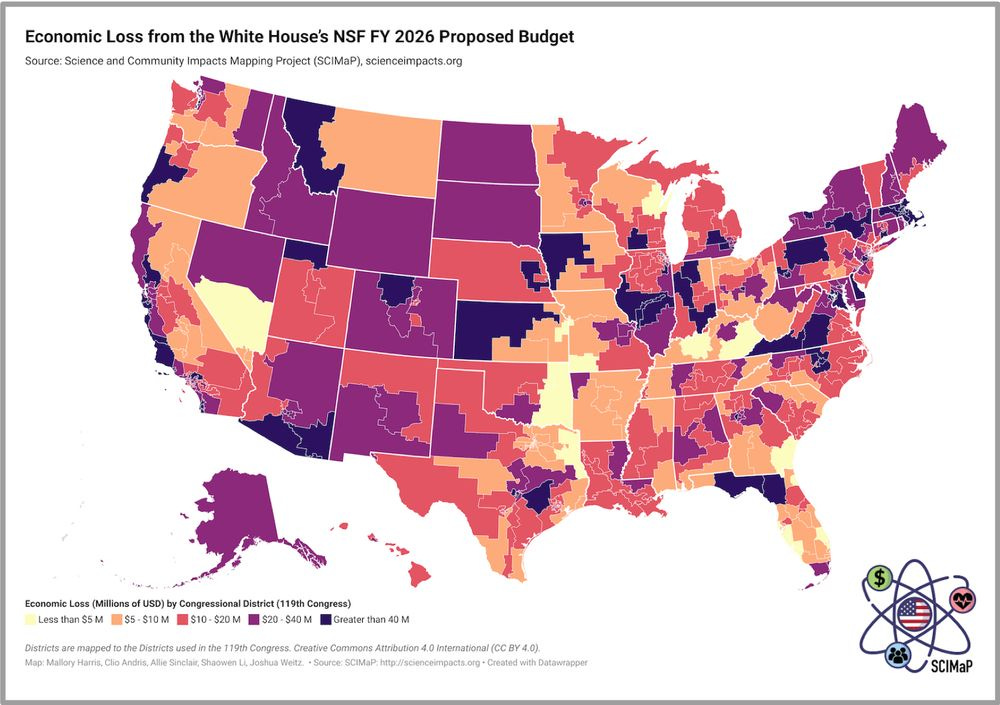
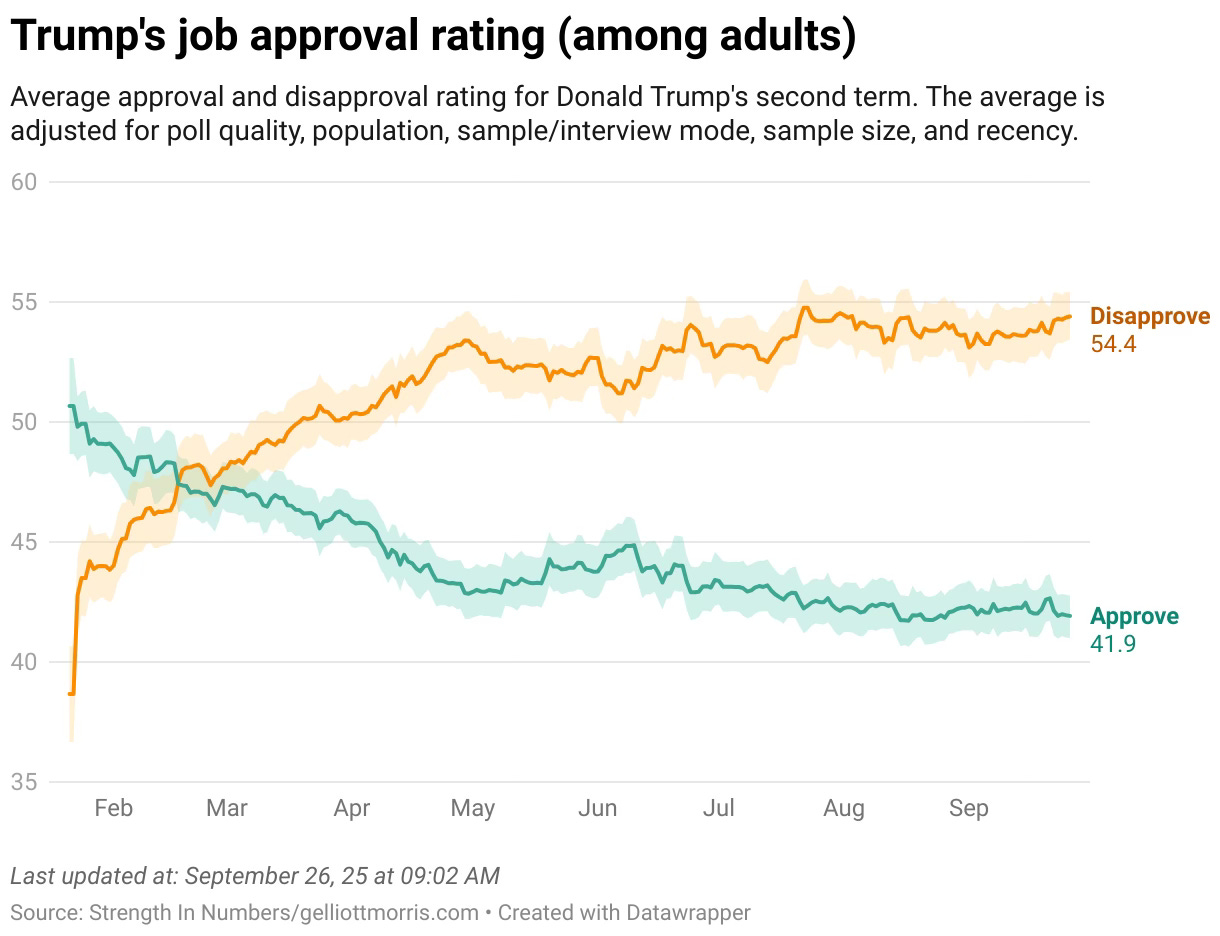
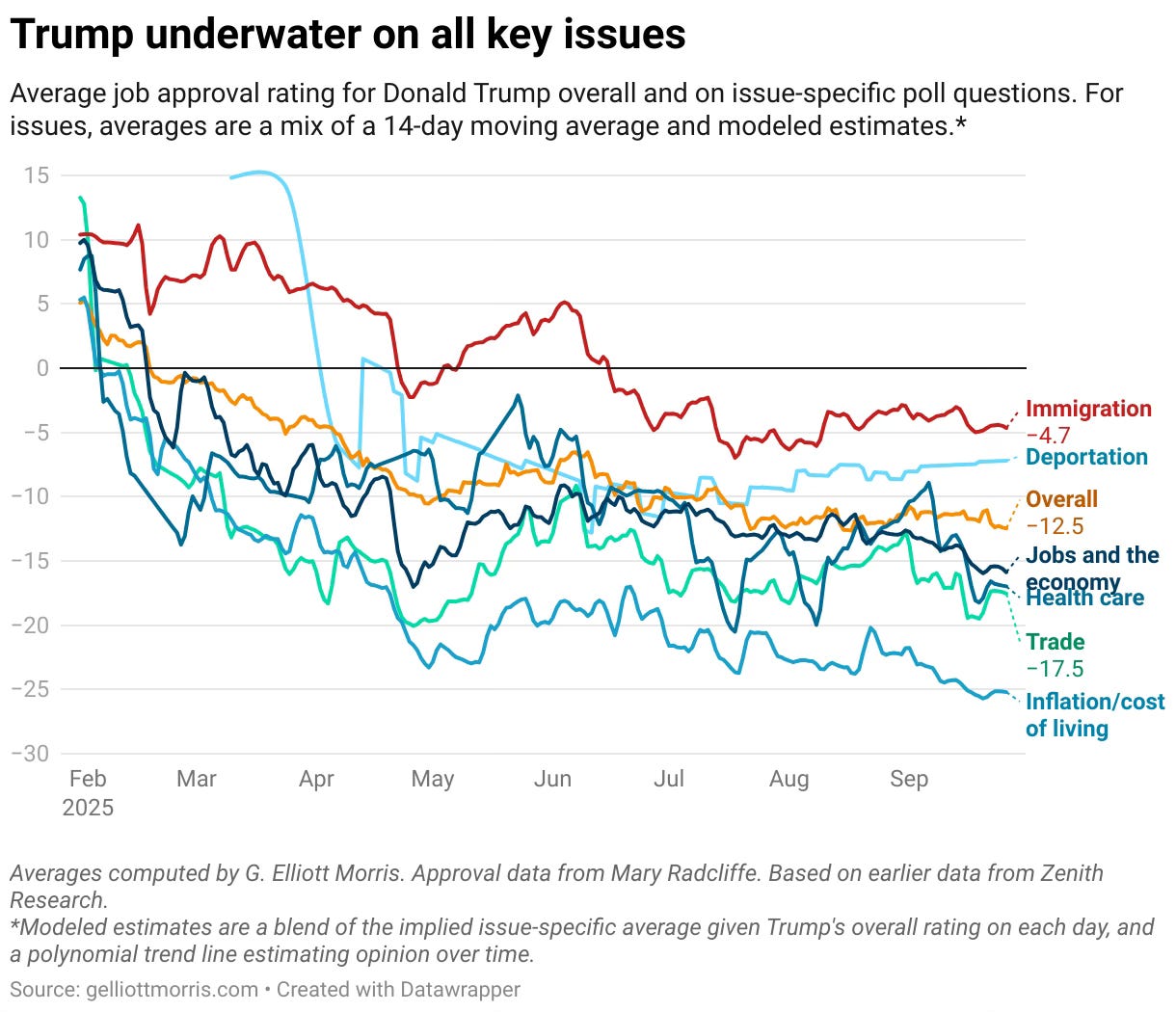
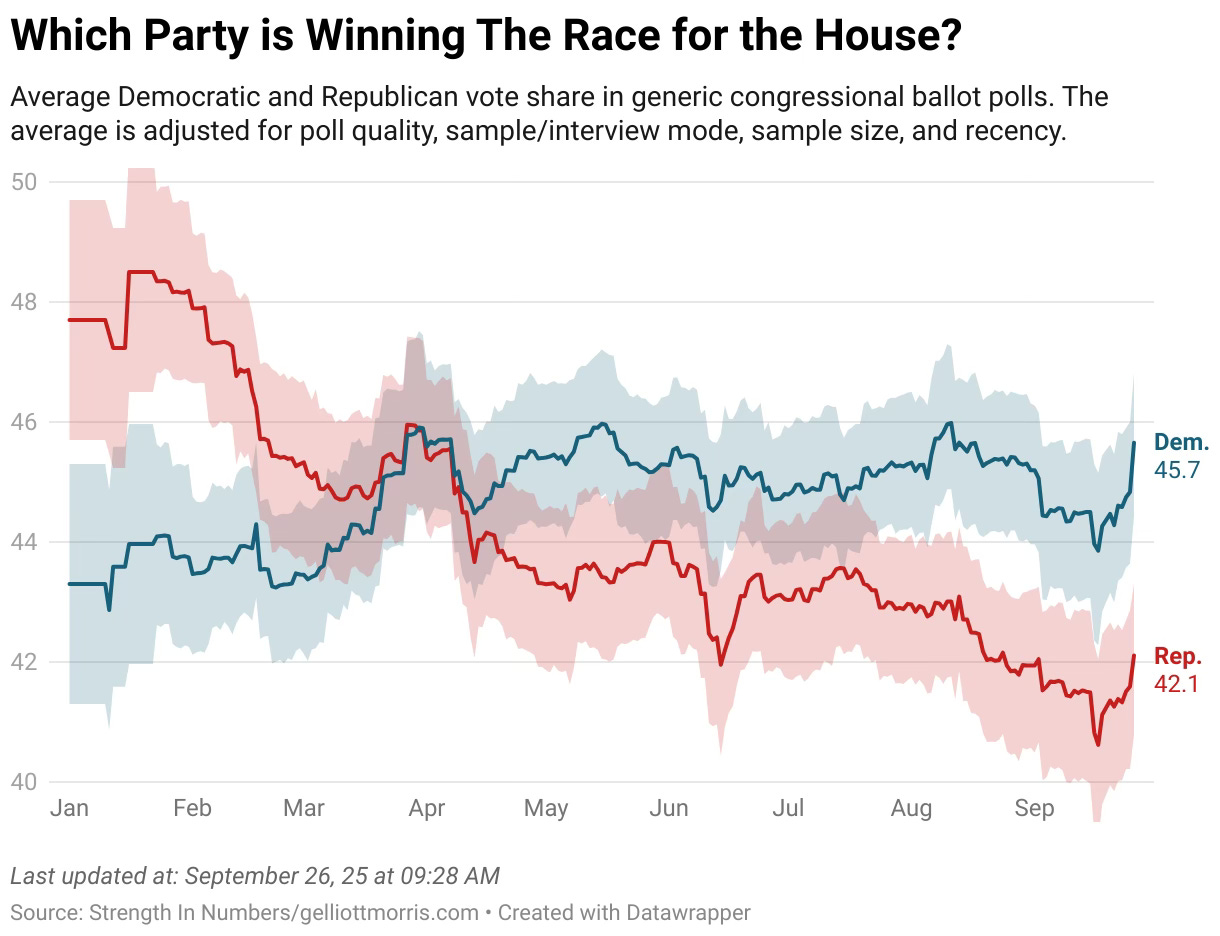
Super nervous about people getting news on TikTok which will soon be in the hands of Larry Ellison, et. al.
Wondering how people view their own lawmakers and lawmakers as a whole re. how Congress responds to things like Executive overreach and literal fascist ideology/fascist agenda, like the authorization to use whatever “full force” is supposed to mean in order to subdue Portland.
Portland!
Also wondering about perception of making homelessness illegal via EO & using the military to remove unhoused people. Because who knows where they are taking them.
I think you and Tim Snyder lead in the % of articles I file as “Important”—thank you so much!
I am so glad to find you though Krugman's substack. I have so missed 538's charts since it disappeared. Many - over 20? - years ago I first encountered Nate (and Paul K) over on Daily Kos after retiring from teaching overseas for years. Thus showing my age... I even have a few years on Krugman. I have bookmarked the charts page and look forward to keeping track. Thanks